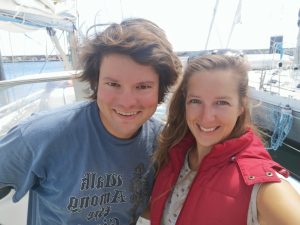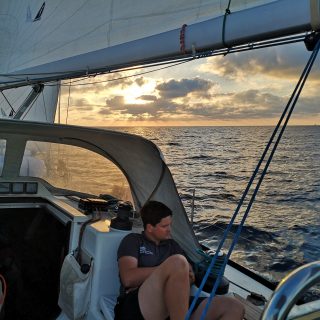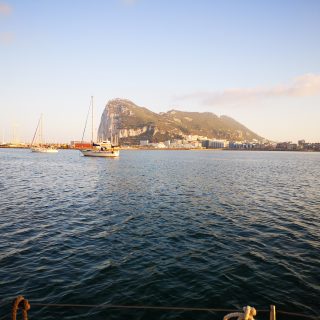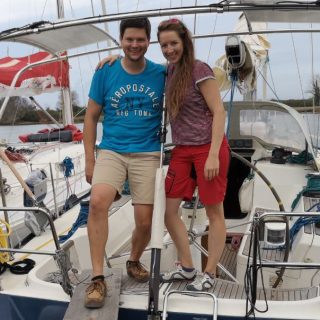Leaving the Azores towards Portugal we experienced one of the most comfortable and smoothest crossing we’ve ever had on this journey. Six days with steady wind, sun shine and swells not too high. Just after leaving Ponta Delgada on Sao Miguel, the sailing life showed us again how small the world was: spotting a boat on the AIS we’ve already met at sea on the way to Bermuda! You can see the outcome of a great photo shoot in the gallery. With high spirits and happy faces we left the Azores, our hearts full of great memories, still amazed by these fascinating islands and the sailors community in Horta.
After six days at sea, one delicious tuna and lots of cargo ships on the way we celebrated our arrival at mainland Europe in Portimao. There was a map of Europe on the table with our planned itinerary and timeline. We decided to bring the boat back to Pisa but the roughly calculated 1000 nautical miles all across the Mediterranean Sea have to be planned well (well it is still about 1/3 of an Atlantic crossing!). After two days in Portimao and another three days in Olhao/Ilha de Culatra, we proudly hoisted the Spanish courtesy flag on the way to Cádiz. We both love Spain and it felt great to be back in the country of tapas, tinto and the late-night lifestyle on the streets. Soon we realized that we’ve definitey arrived in the middle of Spanish tradition: kitchens still closed at 8pm, restaurants opening again between 9 and 10pm, culinary rush hour around midnight. What about an afternoon snack at German dinner time not in order to starve on the way to the tapas bar? No problem to adjust! Another highlight I have to mention here is our trip to Sevilla, including a complete unusual means of transportation on this journey – we decided to go by train. Sevilla and Cádiz are both great and fascinating cities and we enjoyed the heat, tapas on the streets, historic buildings and finally getting to practice our Spanish with local people. We would have loved to stay longer but our schedule on the table reminded us to move on.
It was July 9 when we crossed our track from last year in the bay of Gibraltar. In October last year we had been stuck in La Línea (Spanish city next to Gibraltar) for several days waiting for the right weather window to cross the Strait of Gibraltar on the way to the Canaries. It had been cold, rainy and we hadn’t been able to manage to do all the epoxy repairs with the wet and cold weather outside. With the Atlantic crossing just around the corner we had felt nervous and stressed because of all the things to do (we didn’t know at this time what kind of bad surprise would wait for us in Las Palmas when finding out about the broken spreaders…). Sitting on the cockpit table now in the present, about nine months and 11754.2 nautical miles later, we talked about the memories and feelings from last year and got quite emotional too.
Crossing the path didn’t mean to follow the same route. Instead of sailing along the Spanish south coast, we decided to visit Ceuta, a Spanish exclave on the African continent. From there, we also took the chance to cross the border to Morocco, took a taxi to Tetouan and jumped into a complete different world for one day, different in many aspects. It already began on the border between Europe and Morocco where Moroccans (mostly women) took it literally that hand luggage can be carried tax-free between the two countries. So it’s quite common to see women carrying heavy loads, not only in bags but also wrapped around their waist underneath their flowing robes. There is a reason why this kind of action is called “irregular cross-border trade”. It seemed to be tolerated by both parties, as far as we were able to judge from what we saw. In fact, the atmosphere at customs and across the border was tense with people also climbing over fences and throwing bags to the other side. We really felt like foreigners and we were also treated as such. People trying to offer taxi rides for ridiculous prices but fortunately (unfortunate for them) we knew how much to pay for a ride to Tetouan. It took a while to find a taxi driver who agreed with the normal price. Even if we didn’t know for sure that we would definitely go to Tetouan due to language barriers, we started into our Moroccan adventure in a crowded taxi. The driver luckily did drop us off in Tetouan and we had a great day wandering around the medina and simply soaking up the atmosphere and all the impressions around. In general we felt safe, but not very comfortable at some point, especially me as a woman without a scarf around my hair attracting several men staring at me as if they would have never seen a woman in their entire life. It was weird. No laughter on the streets. No friendly words. People mostly staring at us. We had difficulties to interpret their faces. Maybe despair? We saw a lot of poverty in the Caribbean too but people were always friendly, who treated us and each other with respect (we actually realized that the poorer the people, the more friendly and honest they were). It felt different in Tetouan and I truly felt relieved when crossing the border back to Spain. I took off my scarf around my shoulders and felt safe. Safe and proud to be European. Nevertheless we loved our day trip to this beautiful country and would love to explore more in the future. We also realized how thankful we can be for the freedom which we take for granted. There are so many people who don’t know what it means to be free as we are. Free to make choices. Or free to go on a journey like ours.
Talking about choices, we chose to follow our timeline map towards Cartagena. Another event hit us emotionally on the way. About every hour we received an emergency “Mayday Relay” call via VHF from the Spanish coast guard about a sinking rubber boat with 39 people on board near the Moroccan coast. The Moroccans didn’t seem to care, so a Spanish rescue plane was searching for them and a Spanish rescue boat was sent all the way across the Mediterranean sea (in this case ~ 90 nm/170 km) to pick them up and bring them to Spain. We listened to the rescue mission on our VHF radio and felt a shiver when radio silence was requested in order to avoid any signal disturbing the rescue mission. Some hours later, the rescue boat showed up behind us on the way to Almería and crossed our path. There were a lot of people on the boat, some of them wrapped in black burkas. The radio silence was suddenly broken by Spanish fisherman insulting the Spanish coast guard with slogans such as “bring them back to where they came from” or “don’t bring them into our country”. It was a weird situation. The lucky people with their heros in neon orange overalls slowly disappeared on the horizon and left us alone with our thoughts about the refugee situation in the Med. We often thought about our own rescue plan what to do in case we get into the situation to find refugees in an emergency at sea. Even if we heard about it on the radio many times, we were never close to any of them.
Steady winds finally pushed us to Cartagena, where we spent two days exploring the city and enjoying tapas late at night, making the most out of our Spanish experience. After visiting Cartagena and another stop in Alicante we left mainland Spain to hop over to the Baleares – Ibiza, Mallorca and last but not least Menorca. Overall, we collected many engine hours on our way from Alicante to Menorca. No wind and crowded anchorages could describe the situation in the best way. High season party islands with lots of interesting things to observe, especially sailors who don’t care how to set an anchor properly, going ashore to party, hitting the next luxury motorboat where desperate nicely dressed permanent crew trying to keep away a drifting 50ft sailboat. It’s better than going to the cinema. We just didn’t have any popcorn.
Studying Balearic charts very closely, we finally found THE spots to stay. But it was just out of a coincidence, of better, out of despair. It was windy on that day, exactly from the direction where we wanted to go but we decided to leave for Mallorca. Short, choppy waves made us realize that we won’t make it even close to Mallorca without risking to damage something on the boat. When desperately looking for shelter on the north coast of Ibiza, we found an anchorage which was not indicated in the charts, perfectly protected, isolated and quiet. We had to take a closer look at the bottom to set the anchor on the only sandy spot and enjoyed the peace. It was really peaceful – we didn’t have any phone signal. Good for the daily storm of messages, bad for the passage planning to Mallorca ahead of us. The following day, we took our stand up paddle board to go ashore, climbed the little hill covered in pine trees and took a long walk until we got enough signal to download weather. Four hours for a little bit of internet – what an effort – but it was worth it to explore the peaceful part of Ibiza. How easy it is these days to manage all the sailing topics just with a handful of apps and internet.
Even if the weather looked promising, we had to use the engine for most of the way towards Mallorca and then Menorca. But lucky again – we found similar spots, remote, without internet and peaceful. I still can feel this moment when sitting on deck in the middle of the night, listening to the crickets and the waves hitting rocks, watching stars and bioluminescent jellyfish in the water, feeling the warm air from the mountains on my skin, warm air with the fresh scent of dry pine trees. This moment could go on forever. It feels good to get some rest now after all the crossings, the time pressure crossing the Med, the impressions and the experience day by day. Not to mention the daily effort to take care of our floating home. But what do you think? Going on a long-distance cruise is definitely not a vacation.




Famous Peter Café Sport in Horta – the meeting point for all the sailors after the Atlantic crossing 



Chocolate cake after an ocean crossing – no words needed. 



Stephan preparing the wall in Horta for the painting 



Now our fox made it to Horta – officially. 



After the Atlantic crossing Stephan decided to get a new beard style . And another chocolate cake. 



Stephan’s daily fight with his long hair 



Beautiful nature in Flores 



Leftovers of lava on Faial 



Wanted to have a look at the volcano in Faial, but it was foggy and windy on that day. 



Ready to leave Sao Miguel towards Portugal 



Photo shoot on the coast of Sao Miguel – thanks to Alejandro on SY NDS Evolution 



A jumping squid leaving its “art” on deck 



Being so tired during my morning watch, I tried to keep me awake with funny selfies. 



In the middle of a lot of cargo ships on the way to mainland Europe 



Our timeline across the Mediterranean 



Mainland Portugal – exploring Portimao 



Back to Spain – enjoying the local lifestyle with midnight tapas 



Trip to Sevilla 



Azulejos (traditional colored tiles, mostly blue = azul) 



July 9, crossing our track in the bay of Gibraltar 



SY Johanna in Ceuta 



Adventure Morocco – exploring Tetouan 



Enjoying some mint tea 



Border between Morocco and Spain 



View above Cartagena 



Quite rare on this journey: Shopping! But the old bag was just about to fall apart. 



A quiet spot on Mallorca 



Enjoying the peace 



Peaceful sunset 


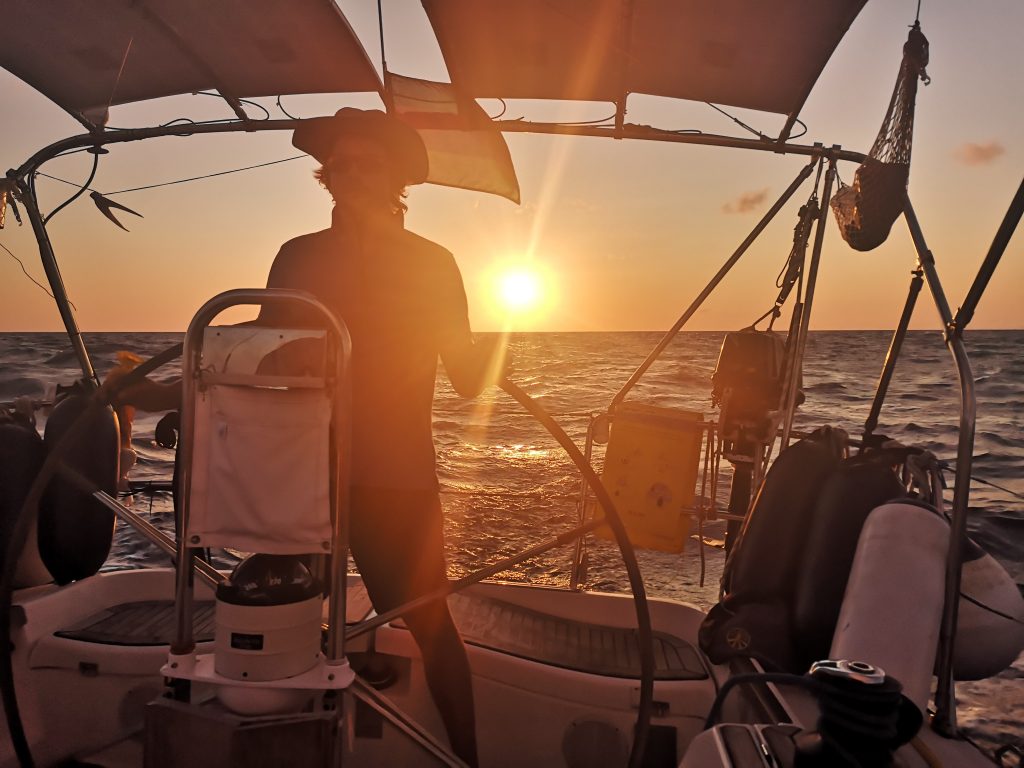
Captain Jack Stephan Sparrow

